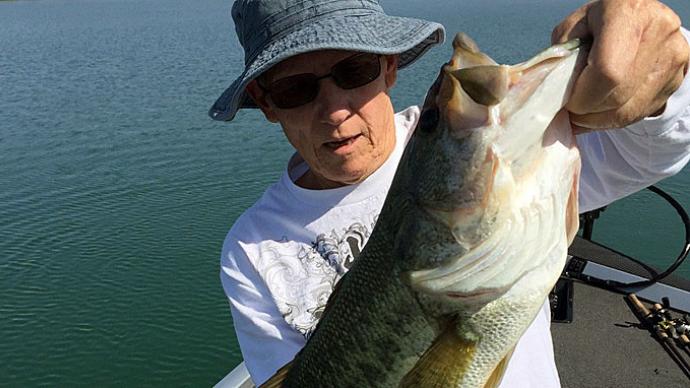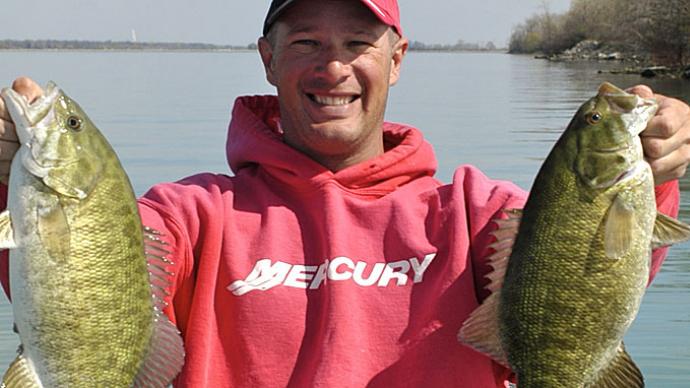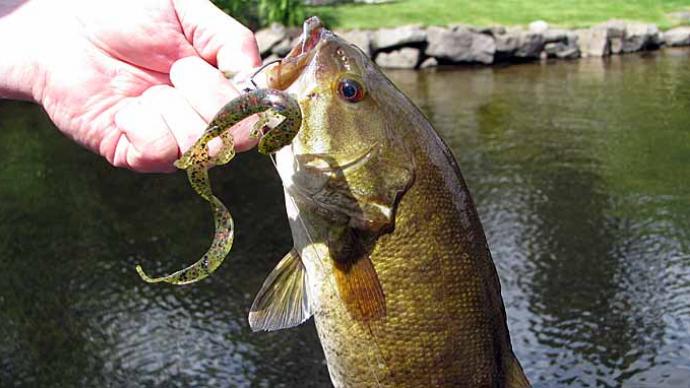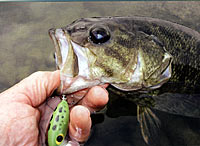
Let's go down to the pond and catch bass. Smallmouth bass. First cast, the floating jitterbug lure plops in the calm water near that jagged log sticking half out of the water. As the ripples disappear, before you can twitch your line to bring the bait to life, the surface erupts as a dandy smallmouth bass takes the bait. The tug-of-war is on between acrobatic fish and angler. You giggle, as you should. That's fun. As you bring the glimmering fish up for a closer examination you think, "Boy that sure is a nice smallie for being only two years old."
How did you grow them so large in just two years?
Stay with me and you will soon see. Smallmouth bass have basic habitat and food needs. In this next series of articles we will explore those needs and provide information how to grow some dandy smallies. Understanding subtleties of this species will allow you to better raise and manage this widely acclaimed, top-of-the-line, trophy of the bass family. Interested? Good, read on.
Busting The Myth
Most all common literature says smallies are typically found and thought to do best in continually cool, deep, rocky northern or midwestern lakes or cool water streams. Another reference says smallies prefer clear, rocky lakes with a minimum of 25-30 feet deep and water temperatures no more than 80 degrees F. Nahh! That's a myth.
Smallmouth bass actually are native to the northern parts of North America that have areas of cooler water with basins lined with boulders, rocks and various sizes of gravel. Smallmouth bass also grow and thrive in many streams of various sizes. Smallies have also been stocked by agencies and citizens in many states of the United States. Water temperatures of some of the mid-western and southern slow, moving streams where smallies thrive are regularly in the mid to high 80 degree F and sometimes even 90 degrees during dog days of summer.
Why the myth?
A classic early study of northern lakes with native smallies concluded these bass prefer to stay in cooler water along deeper rocky ledges. In reality, smallies were forced to compete with other more dominate predators, largemouth bass, who staked their claim to prime shallower habitat spots. Thus, the traditional "preferred habitat areas" of deep, cooler water often reported in early literature were probably the second habitat of choice (out of necessity) for smallies due to competition from largemouth and walleye (Ripley and Sura 1999). In those cases, smallies probably had to inhabit other spots or areas due to bullying from other, more aggressive fish, such as largemouth bass. In the early studies, competitors likely forced smallmouth out of warmer, food-rich shallow areas and to survive, they had to take up residence in cooler deeper locations, places less preferred by largemouth bass. Researchers of those early studies (Dendy 1948, Norris Lake, TN), thus concluded the colder, deeper spots where smallmouth were most commonly found were preferred habitats.
Truth is, smallmouth often are found in cool water, but function quite well in warm, shallow, weedy water when other predator sparse or not present. In scientific literature, laboratory studies have shown smallmouth bass will survive in summer water temperatures of 90-92 F. So, if your pond is not located in the southernmost areas of the United States and water temperatures do not stay above 95 F for weeks at a time, smallies will likely do just fine in your pond or lake.
Contrary to popular belief, smallies do not need extensive rocky, cool water habitats to thrive. They will grow well and reproduce in ponds where largemouth flourish. Personally, I have raised thriving numbers of smallmouth bass up to 20" long that successfully reproduced annually and grew well in a small, seven-foot-deep, clay-bottomed pond where water temperatures in mid-summer frequently reached low 90s. In my region of northwest Ohio, smallmouth do quite well year after year in numerous small ponds where there are no largemouth bass.
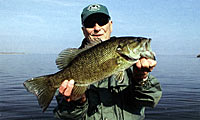
Growing smallies is not always just a matter of adding them to your pond. Pond Boss editor and fisheries biologist, Bob Lusk, as an experiment, stocked smallies in one of his small North Texas ponds. The smallmouth went into the 3/4 acre pond, stocked at the same time with walleye, just for fun. Lusk stocked 12, 6-8 inch smallmouth with 13 similar size walleye. The pond was freshly filled with well water and fish were stocked in November, 2003 along with fingerling bluegill sunfish. The next spring, Lusk added some extra channel catfish he had and began to feed the fish with an automatic feeder. A seine survey in November, 2004 showed both smallmouth and walleye survived a relatively "cool" Texas summer. But, since then, not one smallmouth or walleye has been seen. But, the channel cat are thriving and largemouth bass infiltrated from ponds upstream during a minor flood event. However, results and survival of smallmouth and walleye were poor. I am not sure why they did not survive, but I don't think it was due to high water temperatures.
In Phoenix, Arizona, a member of the Pond Boss Forum and avid Pond Boss subscriber, Aaron Matos, has smallies growing and reproducing in a small 0.17 acre, shallow pond in his backyard. It's not just any pond, though. He has a wetland filtration system and the plastic-lined pond is loaded with rocks and boulders strategically placed along shelves and ridges. Great habitat, but even with all the "perfect" habitat, water temperatures of this pond were measured to be 92 to 95 F when air temperatures are frequently 100 F or more. Phoenix has an average 21 days a year where air temps reach 110 F. His water is often more like bath water than smallmouth bass water. Yet they thrive.
As an in-between species in a mixed community of fish, smallies will function the best they can and will inhabit areas not already occupied by more dominant fish. A couple of studies have shown smallies do not compete well with bluegills, green sunfish or bullheads. In these situations, the bigger the pond and the more diverse the structures, then the more areas will be available for smallies to hang out and survive. When largemouth are present, the largemouths will dominate and bully smallies into locating to other less desirable areas of the pond. Dr. Dave Willis, fisheries biologist from South Dakota, and numerous others including this author have found that when combined with largemouth, the smallie population always gradually declines without regular supplemental stocking of large juveniles or adults.
By themselves as the dominant predator in the pond, smallies will occupy the same type of shallow habitat and locations preferred by largemouth and some other panfish. Thus, many ponds able to grow largemouth will grow smallies, especially if competition with other, more aggressive fish is low.
Smallmouth bass have been reported to have much less inclination to school than largemouth (Mraz 1964d). However, I (and others) have watched juvenile smallmouth in small ponds hunt in packs of 5-10 fish as they crowd and attack small forage fish herded by the bass into shallow water. Many good bass anglers know that numerous smallies can be caught from one small area. In winter, smallies will congregate in schools in deeper water areas.
Myth Circle
Temperature myths about smallies requiring clear, cool, rocky bottom habitats have been prolonged by combined writings of outdoor writers and authors of fishery journals (Ripley and Sura 1999). Early fishing and semi-pro fishery writers referred only to basic early research in their articles. Wildlife and Natural Resource agencies often repeated the temperature myths found in fishery-related books and magazines.
Even today, angling writers, who have not carefully reviewed detailed scientific literature regarding temperature tolerances of smallmouth bass are still referencing the old mythical literature. Thus, the circle of errors about temperature myths for smallies are still commonly repeated. So, what has been written up to now in many articles may not tell the whole story about this fascinating fish.
Smallmouth Bass Food Chain
Smallies are primarily sight feeders and are usually inactive at night when they can be easily approached by SCUBA divers. Peak feeding periods are often in lower-light periods, such as dusk and dawn.
Smallies tend to prefer smaller food items compared to a similar sized largemouth bass.
Smallies are reported as opportunistic feeders and will eat most critters that they come across including small snakes, frogs, mice, leeches, worms, insects, crayfish and all types of smaller fish. At certain times of the year smallmouth will feed almost exclusively on one type of food when it is abundant. In the northeast and Great Lakes region, smallies are known to exclude other prey and feast on smaller yellow perch when they are abundant (Black 2007).
It is widely known that crayfish and soft-ray bait fish form a major part of the diet of smallies in many lakes and streams. In waters where crayfish are abundant they will, at times, compose almost all of the smallie diet (Danehy and Ringler 1991). One study found smallmouth ate more crayfish and tadpoles than bluegills and golden shiners. Sometimes during the year, small fish will form a large part of the smallie diet when bugs, tadpoles, and crayfish are scarce and when small fish are common. Opportunistic feeding is important for smallies.
I think the key to growing great smallies is ample and diverse foods available year round. Without abundant food, smallies have to expend too much energy locating, chasing, and catching a food item. If the prey item moves too fast or is too small or too large, it does not serve well as the best type of food and that fish's growth will not be the best it can be.
Dr. Bruce Condello has described the optimal foraging theory several times in earlier Pond Boss articles. Optimal foraging consists of using as little energy as possible to gather the most amount of food in the shortest time possible. This concept applies well to growing great smallies and other prized fish in your pond. Stock and keep plenty of the right types and proper sizes of forage foods available for each size class of fish.

As seasons change, different foods are available. The main hatch or emergence of different types of insects occurs during specific months. Summer and fall are when most young of the year fish are available. Crayfish and insects are usually dormant in fall and winter. The sizes of food items change due to growth; as in young of year fish. Remember, as predators grow they are able to eat larger and larger food items.
Many ideal-size food items as crayfish and young of the year fish are seasonal. Crayfish have seasonal periods where they become inactive and dormant and then are unavailable or too small as commonly encountered food items. Late in the year or real early spring, young fish of perch, shiners or sunfishes have been cropped and most remaining fish have grown too large for many smallies. Then, smallies have to feed on alternative foods to maintain good body weight and growth.
If you can get smallies to feast on a diet of high protein pellets, then optimal foraging is really working for your fish. These bass will always have ample food during the growing season and will continue to grow well, even when other preferred natural foods are sparse.
Secondly, if you want a truly good smallie pond, they should not have to compete with largemouth or other numerous predators for those prime food items. For the very best results, keep largemouth bass out of your smallmouth bass pond.
Several studies have shown water containing high amounts of silt reduced viability of smallmouth bass populations. Thus, smallmouth bass will not usually do well in a pond continually turbid from suspended sediment.
In controlled fishing studies, smallies were found to be more vulnerable than largemouths to anglers, especially in June and September. Thus, heavy fishing pressure and harvest of adult fish can have more detrimental effects in a smallie pond compared to a largemouth pond. In good conditions, sometimes smallies will overpopulate and thoughtfully reducing their numbers is necessary for good growth of remaining fish.
So, all these factors bring us here. Temperature stocking guidelines for smallmouth bass have probably been over emphasized. Want smallmouth bass? Provide a healthy, clean pond with good habitat. Make sure smallmouth bass have a wide variety of small- to mid-sized food available-from insects to minnows to freshwater shrimp to yellow perch or maybe some sunfish. Be careful to avoid direct competition with other large predators. Smallmouths don't compete well with many fish in the pond or small lake habitat.
Do these things and you, too, can grow smallmouth bass.
Reprinted with permission from Pond Boss Magazine

